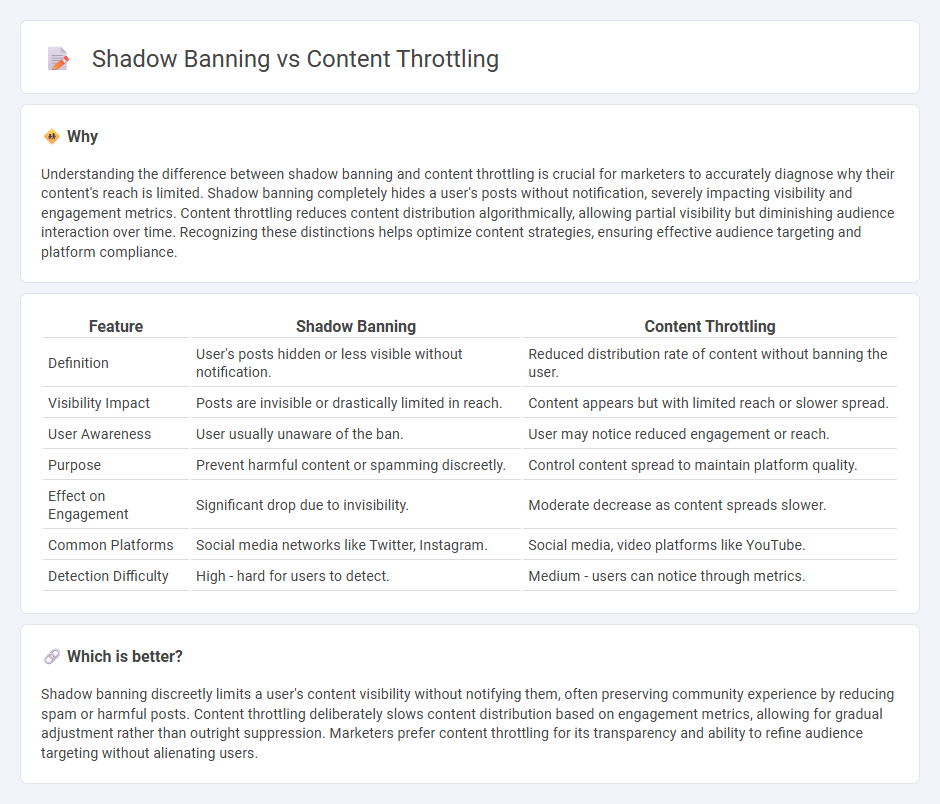
Shadow banning limits content visibility without user knowledge by reducing its reach on social platforms, while content throttling systematically restricts distribution based on factors like engagement metrics or policy compliance. These practices impact digital marketing strategies by altering organic audience growth and influencing algorithmic content delivery. Explore deeper insights on how these techniques affect online brand presence and marketing effectiveness.
Why it is important
Understanding the difference between shadow banning and content throttling is crucial for marketers to accurately diagnose why their content's reach is limited. Shadow banning completely hides a user's posts without notification, severely impacting visibility and engagement metrics. Content throttling reduces content distribution algorithmically, allowing partial visibility but diminishing audience interaction over time. Recognizing these distinctions helps optimize content strategies, ensuring effective audience targeting and platform compliance.
Comparison Table
| Feature | Shadow Banning | Content Throttling |
|---|---|---|
| Definition | User's posts hidden or less visible without notification. | Reduced distribution rate of content without banning the user. |
| Visibility Impact | Posts are invisible or drastically limited in reach. | Content appears but with limited reach or slower spread. |
| User Awareness | User usually unaware of the ban. | User may notice reduced engagement or reach. |
| Purpose | Prevent harmful content or spamming discreetly. | Control content spread to maintain platform quality. |
| Effect on Engagement | Significant drop due to invisibility. | Moderate decrease as content spreads slower. |
| Common Platforms | Social media networks like Twitter, Instagram. | Social media, video platforms like YouTube. |
| Detection Difficulty | High - hard for users to detect. | Medium - users can notice through metrics. |
Which is better?
Shadow banning discreetly limits a user's content visibility without notifying them, often preserving community experience by reducing spam or harmful posts. Content throttling deliberately slows content distribution based on engagement metrics, allowing for gradual adjustment rather than outright suppression. Marketers prefer content throttling for its transparency and ability to refine audience targeting without alienating users.
Connection
Shadow banning and content throttling both limit a user's visibility on digital platforms to control content distribution without direct notification. Shadow banning hides posts or accounts, significantly reducing engagement and reach, while content throttling slows down content delivery, making it less likely to appear in users' feeds. These tactics are employed by marketing algorithms to manage platform health, user experience, and adherence to community guidelines.
Key Terms
Reach Limitation
Content throttling reduces the visibility of posts by limiting their distribution across user feeds, directly impacting reach and engagement metrics. Shadow banning involves discreetly restricting content or user activity without notification, leading to significant reach limitation without user awareness. Explore in-depth differences and detection methods to better understand reach manipulation.
Algorithmic Suppression
Algorithmic suppression in content throttling limits the visibility of posts by reducing their reach without notifying the user, effectively slowing content distribution through platform algorithms. Shadow banning goes further by hiding user content from public feeds or search results altogether, often without informing the user or giving clear reasons. Explore the nuances and impacts of algorithmic suppression techniques to better understand content moderation strategies.
Visibility Control
Content throttling restricts the reach of posts by limiting their distribution in algorithms, reducing visibility without alerting the user. Shadow banning invisibly suppresses user content entirely, making it virtually invisible to others while the user remains unaware. Explore these critical visibility control tactics to better understand their impact on online engagement.
Source and External Links
What is Mobile Data Throttling? Causes, How to test & fix it - Content throttling is when an ISP or mobile carrier intentionally slows down your internet speed for specific content types like video streaming, peer-to-peer sharing, or even certain websites, usually to manage bandwidth or encourage higher-tier plans.
What Is Throttling? - Dev Proxy - Throttling is a technique used by cloud APIs to limit the number of requests over a time period to maintain service availability and prevent resource overuse, often indicated by HTTP 429 errors.
Bandwidth throttling - Bandwidth throttling involves limiting communication speed on a network to prevent overuse of resources, either by reducing data transfer speed or applying caps, often targeting heavy users or bandwidth-intensive activities.
 dowidth.com
dowidth.com